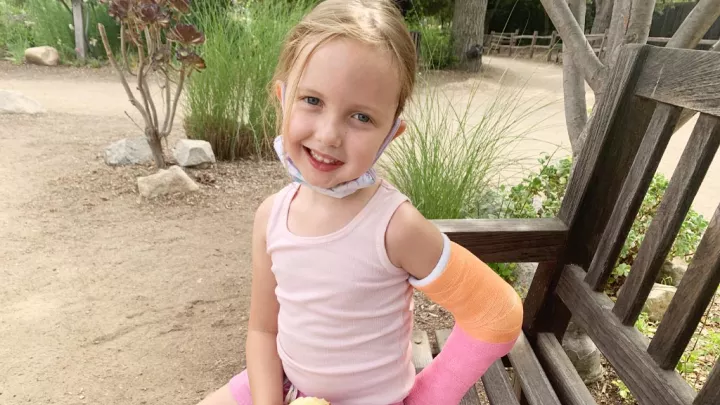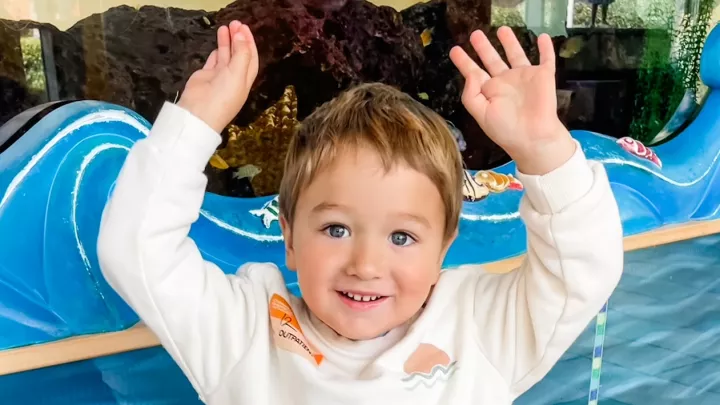
Nursemaid Elbow 101
Nursemaid elbow has many names: pulled elbow, radial-head subluxation, annular ligament displacement. Basically, it occurs when the elbow is pulled into malalignment or partially dislocated.
Whatever you decide to call it, it’s pretty scary the first time it happens to your kid. If you aren’t there to witness the trauma, you may just see your child withholding from using the affected limb as if it is paralyzed. Your child may not even seem to be in pain, but may cry at your attempts to touch or move the arm, leaving you to think: Is it broken?
All the what-ifs or the speculation on what could have possibly happened will run through your head, along with the immediate guilt you’ll feel if it happens when you picked up your little one or you were holding hands. But rest assured, Children’s Hospital Los Angeles orthopedic surgeon Erin Meisel, MD, says—it’s not your fault.
Dr. Meisel's experience with nursemaid elbow is not just professional but also personal—her daughter has had multiple episodes of it. Below, Dr. Meisel, the co-Director of CHLA's Brachial Plexus Program, explains what the injury looks like and how to treat it, since because of the rough-and-tumble nature of small children, it's not so easy to avoid.
What the numbers say
For starters, Dr. Meisel provides the data. The median age for the occurrence of nursemaid elbow is about 2 ½ years old, she says, adding that the injury happens to girls more than boys and to the left arm more than the right, and is more common in kids in about the 75th percentile in weight.

“My daughter was the classic patient," Dr. Meisel says. "Female, left arm, over 75th percentile in weight."
She says the statistics only describe the condition's tendencies, but it can strike any child. Once it occurs, Dr. Meisel says, it is not uncommon for it to recur, noting that after her daughter suffered her first incident of nursemaid elbow, it has since happened four times in the past five years. "Fortunately, it doesn’t typically occur, or stops recurring, after the age of 6 or 7.”
Dr. Meisel says the injury can happen in a multitude of ways that you can’t foresee. It can happen simply as you’re holding your child’s arm when he or she trips, and you reflexively hold on tighter to stop the fall, a scenario that happens a lot with toddlers because they often fall or impulsively change directions without notice.
In addition, toddlers’ anatomy differs, Dr. Meisel explains. "The radial head is smaller and the annular ligament is thinner," she says. "As a result, the toddler arm easily slips out of its socket."
Kids who have had it once may well have it happen again. Dr. Meisel's daughter had it happen at preschool while simply swinging arms with her best friend. Bottom line: It happens.
So how can you prevent nursemaid elbow without encasing your kids in bubble wrap? It helps to know the signs and symptoms, which Dr. Meisel breaks down below.
Signs and symptoms
- History of prior incidents of nursemaid’s elbow
- Pain with movement, typically with supination/pronation (hand faceup, then down) rather than flexion/extension from the elbow (elbow bent, then straightened)
- Pseudoparalysis – child voluntarily keeps the limb still, typically with hand facedown
- Elbow slightly bent
- Tenderness at the outside point of the elbow
- Persistent complaints of pain despite no visible dislocation, deformity, bruising, swelling, or injury
Two techniques to treat it
Although both of the following techniques are used widely by pediatricians, Dr. Meisel says research suggests that hyperpronation is more effective and less painful than supination. She has tried both on her daughter.
"The supination technique worked the first two times," she says, "and since then, hyperpronation has been our go-to."
She says that typically with both methods, doctors manipulate the child's arms to relieve the injury, producing a “pop” or “click," and within seconds the child is back to moving the arm as if nothing happened.
In hyperpronation, the doctor turns the hand toward a thumbs-down position before moving the elbow back into place. In supination, the doctor turns the palm of the hand faceup before resetting the elbow.
Dr. Meisel advises parents to treat nursemaid elbow the same as any condition their child appears to be experiencing: Make sure to contact your physician to decide what to do next.


